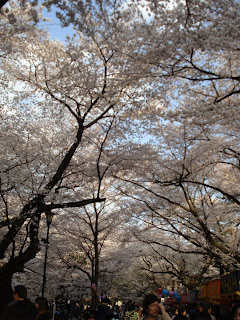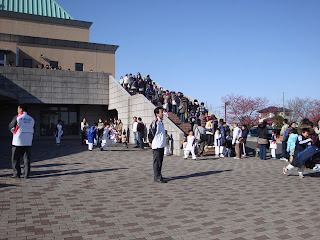 Erica here.
Erica here.This past week, cherry blossoms all over Tokyo were in full bloom. Two weekends ago, I went hanami-ing? (is that the right term?) The kanji for hanami is 花見. 花 = hana = flower, 見 = miru = to see. I went to Omiya-koen (Omiya park) one day and Kinrin-koen (in Sugito) the next day with Yoshinhara Sensei.
We have cherry blossoms in Vancouver as well, but it is nothing compared to Japan.
At Omiyakoen, a big area of the park was filled with sakura trees and in every which direction you looked was a canvas of cherry blossoms. It was breath taking and definitely a must-see if you visit Japan around this time.
Then last Saturday after karate class, two very nice guys from the dojo (Okano-san and Hirai-san) took Louise and I to Gongendo in Satte city to view cherry blossoms at night. This is apparently called yozakura. Gongendo is popular site to see sakura because it has a 1km path with cherry blossoms on either side of it. At night, there are flood lights that shine on them so they can be seen. I was told that the yozakura is for all the people who work during the day and don't have a chance to go see the cherry blossoms. So after work, when it is dark out, they light up popular areas with sakura so that people can enjoy at anytime of the day.
Seeing cherry blossoms at night is completely different than during the day. It might be the romantic/mysterious aura that is given off by the contrast of dark and light and something so beautiful. It was a very memorable experience!













